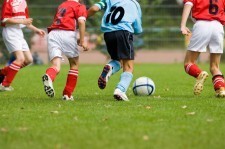When is my child ready for sports?
Children of all ages need physical activity. For many, playing organized sports (such as being part of a soccer team or taking gymnastics lessons) is a fun way to keep active. To get the most benefit out of any sport, children need certain basic skills. And some of these skills depend on a child’s age. If they’re not ready, children may get frustrated and not want to play at all.
What are the basic skills my child needs to play organized sports?
Learning skills like throwing, running and jumping is a normal process that children go through. They learn each skill in little bits, and some learn faster than others. By the time your child is between 3 and 5 years old, they will have learned some of these basic skills.
How do these skills affect my child’s ability to play organized sports?
To play organized sports, children need to learn how to put these skills together (for example, how to run and throw at the same time). That doesn’t happen until your child is about 6 years old.
When your child is young, sports can be adapted to make it easier to play. For example, you can:
- use smaller equipment,
- change roles or positions often, such as having the catcher become a fielder for a while,
- make games and practices shorter, and
- make the game fun so that your child wants to keep playing.
When should my child start to play in an organized sport?
Your child can start playing an organized sport when they have the skills needed to play. Encourage your child to play sports they likes, but also encourage them to try different sports when possible. This will help them learn different skills.
A great Canadian resource for parents deciding when a child is ready for sports is from Sport for Life, called Long Term Athlete Development.
How do I know if my child is ready to play a specific sport?
This chart may also be helpful. It shows the skills that children usually have at different ages and the sports they can start to play.
| Early childhood: 3 to 5 years old | Middle childhood: 6 to 9 years old |
Late childhood: 10 to 12 years old |
Early teens: 13 to 15 years old |
Late teens: 16 to 18 years old |
|
|---|---|---|---|---|---|
| Motor skills (movement) | Can run, jump, throw. Has some balance. |
Basic skills (running, jumping, throwing) are getting better.
|
Getting better at harder skills (such as kicking a ball into a net).
|
Growth spurts; body becomes less flexible.
|
Skills are closer to an adult level. |
| Vision |
Not mature.
|
Getting better at judging speed of moving objects, but still has trouble judging direction of moving objects. | Fully developed (as good as that of an adult). | Fully developed. | Fully developed. |
| Learning |
Very short attention span.
|
Short attention span.
|
Better attention span.
|
Better attention span.
|
Good attention span.
|
| Skills to focus on at this age |
Learns basic skills.
|
Practice basic skills and learn harder skills. |
Practice skills.
|
Individual strengths. | Individual strengths. |
| Suggested activities | Running, tumbling, throwing, catching, riding a tricycle. | Entry-level soccer and baseball, swimming, running, gymnastics, skating, dance, racquet sports such as tennis, riding a bicycle, non-contact martial arts. | Entry-level football, basketball and ice hockey. |
Early-maturing boys: track and field, basketball, ice hockey.
|
All sports depending on interest. |
Additional resources
Reviewed by the following CPS committees
- Healthy Active Living and Sports Medicine Committee
Last updated: June 2018

